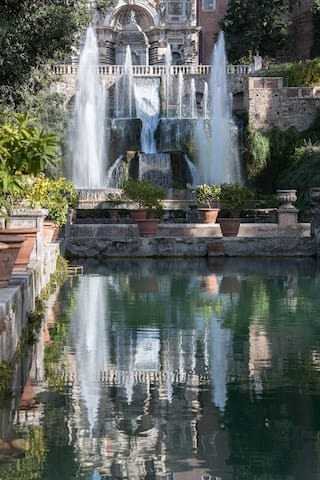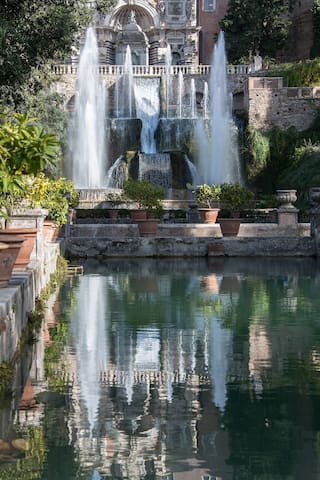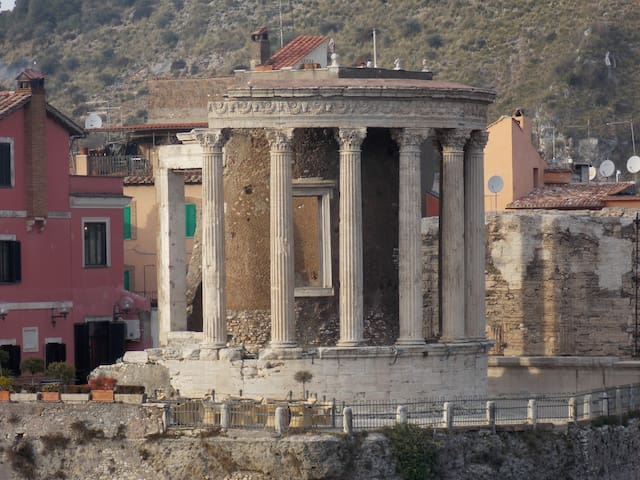tourist information about the city
Some suggestions to discover the historical, artistic and naturalistic treasures of the city of Tivoli
You come to visit Tivoli for its most precious treasures: Villa d'Este, a sixteenth-century masterpiece of the Italian Renaissance and the imperial Roman residence of Villa Adriana, sites so unique and so different but both belonging to the UNESCO World Heritage Site (Info: https://www.levillae.com/).
But Tivoli is able to offer the attentive visitor a much more complete experience, an experience appreciated since the 19th century by European aristocrats traveling on the Grand Tour.
The discovery of the origins of this city can only start from the Acropolis, a spur of rock extending over the valley of Hell, the ravine dug over the millennia by the river Aniene, on which the Temples of Vesta and Sibilla (I and II century BC).
Directly from the Acropolis you can access the FAI nature park of Villa Gregoriana, an area of great natural, historical and archaeological value, which has become the main subject in the pictorial representations of Tivoli of the 19th century Grand Tour, due to the presence, among the other, the majestic Cascata Grande, over 120 m high, and numerous other waterfalls, produced by the Aniene river, which stand out among the luxuriant vegetation. The park delimits the most suggestive area of the so-called Valle dell'Inferno, the valley dug by the Aniene over the millennia which, among caves, tunnels and the ruins of the Roman domus of Manlio Vopisco, in the deepest part disappears, noisily, in the natural sinkhole of the Sirens' cave (Info : https://www.fondoambiente.it/luoghi/parco-villa-gregoriana).
Leaving the Acropolis, following the natural slope of the ancient route of the Via Tiburtina, which for centuries was an obligatory passage for transhumance from the Abruzzo hills towards the Roman countryside, stands the imposing archaeological site of the Sanctuary of Hercules Victor ( II BC), one of the major sacred complexes of Roman architecture. Inside the site, the only one of its kind in Italy, you can embark on a journey through time, due to the suggestive superimposition of the evidence of the history of the last twenty centuries: initially built as a place of worship, it later became a convent, foundry, hydroelectric finally, until the 1950s, it housed a paper mill, of which traces of industrial archeology are still visible (Info: https://www.levillae.com/).
With a leap of over ten centuries, going up through the intricate network of alleys of the medieval quarter, one gets closer and closer to the heart of the city, along a historical path, characterized by some of the most beautiful churches in Tivoli: the Romanesque church of San Silvestro, famous for the apsidal frescoes of the 12th century, dedicated to the saint and the emperor Constantine; the Cathedral dedicated to San Lorenzo martyr, originally built in the fifth century. on the civil basilica of the ancient Tiburtine forum, recently the subject of major restoration works that have restored splendor to the frescoes painted in the Baroque era; adjacent to the church, there are the ancient public wash houses, fed by the waters of the Aniene, and the remains of the ancient Ponderaria table from the 1st century. B.C..
Finally, combined with the villa d'Este complex, the church of Santa Maria Maggiore, the most important and perhaps the most beautiful place of worship in the city, also due to the presence of the Cosmatesque floor and important works of art, in addition to the tomb of Cardinal Ippolito II d'Este.
Our walk in the historic center of Tivoli can only end with the most romantic experience: a visit to the gardens of Villa d'Este, at sunset, when a gentle sun caresses the branches of the trees and enhances the richness of the gardens and the extraordinary variety of water games, fruit of the ingenious genius of Pirro Ligorio.
Just outside Tivoli, following the ancient road of San Marco, an easy path among the olive trees, rich in numerous testimonies of Roman villas, you reach Villa Adriana, the most representative site, left in Tivoli by the Romans, famous throughout the world and also included in the UNESCO world heritage. Currently, the area that can be visited is about forty hectares and includes residential structures, spas, nymphaeums, pavilions and gardens. Almost all the main museums and collections in the world count among their exemplary works from Villa Adriana.
Any stay in Tivoli can only end with a dip in the pools of the nearby Acque Albule - Terme di Roma, a spa center, fed by springs of sulphurous waters, known since ancient times for their beneficial properties. The establishment is equipped with four pools of sulphurous water at a constant temperature of 23 ° C, with a total area of about 6,000 square meters, a therapy center recognized by the National Health Service and a wellness center.
101 personas del lugar lo recomiendan
TIVOLI
30 Str. RoccabrunaYou come to visit Tivoli for its most precious treasures: Villa d'Este, a sixteenth-century masterpiece of the Italian Renaissance and the imperial Roman residence of Villa Adriana, sites so unique and so different but both belonging to the UNESCO World Heritage Site (Info: https://www.levillae.com/).
But Tivoli is able to offer the attentive visitor a much more complete experience, an experience appreciated since the 19th century by European aristocrats traveling on the Grand Tour.
The discovery of the origins of this city can only start from the Acropolis, a spur of rock extending over the valley of Hell, the ravine dug over the millennia by the river Aniene, on which the Temples of Vesta and Sibilla (I and II century BC).
Directly from the Acropolis you can access the FAI nature park of Villa Gregoriana, an area of great natural, historical and archaeological value, which has become the main subject in the pictorial representations of Tivoli of the 19th century Grand Tour, due to the presence, among the other, the majestic Cascata Grande, over 120 m high, and numerous other waterfalls, produced by the Aniene river, which stand out among the luxuriant vegetation. The park delimits the most suggestive area of the so-called Valle dell'Inferno, the valley dug by the Aniene over the millennia which, among caves, tunnels and the ruins of the Roman domus of Manlio Vopisco, in the deepest part disappears, noisily, in the natural sinkhole of the Sirens' cave (Info : https://www.fondoambiente.it/luoghi/parco-villa-gregoriana).
Leaving the Acropolis, following the natural slope of the ancient route of the Via Tiburtina, which for centuries was an obligatory passage for transhumance from the Abruzzo hills towards the Roman countryside, stands the imposing archaeological site of the Sanctuary of Hercules Victor ( II BC), one of the major sacred complexes of Roman architecture. Inside the site, the only one of its kind in Italy, you can embark on a journey through time, due to the suggestive superimposition of the evidence of the history of the last twenty centuries: initially built as a place of worship, it later became a convent, foundry, hydroelectric finally, until the 1950s, it housed a paper mill, of which traces of industrial archeology are still visible (Info: https://www.levillae.com/).
With a leap of over ten centuries, going up through the intricate network of alleys of the medieval quarter, one gets closer and closer to the heart of the city, along a historical path, characterized by some of the most beautiful churches in Tivoli: the Romanesque church of San Silvestro, famous for the apsidal frescoes of the 12th century, dedicated to the saint and the emperor Constantine; the Cathedral dedicated to San Lorenzo martyr, originally built in the fifth century. on the civil basilica of the ancient Tiburtine forum, recently the subject of major restoration works that have restored splendor to the frescoes painted in the Baroque era; adjacent to the church, there are the ancient public wash houses, fed by the waters of the Aniene, and the remains of the ancient Ponderaria table from the 1st century. B.C..
Finally, combined with the villa d'Este complex, the church of Santa Maria Maggiore, the most important and perhaps the most beautiful place of worship in the city, also due to the presence of the Cosmatesque floor and important works of art, in addition to the tomb of Cardinal Ippolito II d'Este.
Our walk in the historic center of Tivoli can only end with the most romantic experience: a visit to the gardens of Villa d'Este, at sunset, when a gentle sun caresses the branches of the trees and enhances the richness of the gardens and the extraordinary variety of water games, fruit of the ingenious genius of Pirro Ligorio.
Just outside Tivoli, following the ancient road of San Marco, an easy path among the olive trees, rich in numerous testimonies of Roman villas, you reach Villa Adriana, the most representative site, left in Tivoli by the Romans, famous throughout the world and also included in the UNESCO world heritage. Currently, the area that can be visited is about forty hectares and includes residential structures, spas, nymphaeums, pavilions and gardens. Almost all the main museums and collections in the world count among their exemplary works from Villa Adriana.
Any stay in Tivoli can only end with a dip in the pools of the nearby Acque Albule - Terme di Roma, a spa center, fed by springs of sulphurous waters, known since ancient times for their beneficial properties. The establishment is equipped with four pools of sulphurous water at a constant temperature of 23 ° C, with a total area of about 6,000 square meters, a therapy center recognized by the National Health Service and a wellness center.
our favorite places
You just need to look out the window of our apartment to enjoy the spectacular view of the gardens of Villa d'Este, a sixteenth-century masterpiece of the Italian Renaissance.
There are not enough words to describe the emotion one feels at first sight.
We suggest visiting them at sunset, when a gentle sun caresses the branches of the trees and enhances the richness of the gardens and the extraordinary variety of water features, fruit of the ingenious genius of Pirro Ligorio.
Info: https://www.levillae.com/
182 personas del lugar lo recomiendan
Villa d'Este
5 P.za TrentoYou just need to look out the window of our apartment to enjoy the spectacular view of the gardens of Villa d'Este, a sixteenth-century masterpiece of the Italian Renaissance.
There are not enough words to describe the emotion one feels at first sight.
We suggest visiting them at sunset, when a gentle sun caresses the branches of the trees and enhances the richness of the gardens and the extraordinary variety of water features, fruit of the ingenious genius of Pirro Ligorio.
Info: https://www.levillae.com/
The archaeological site of the Sanctuary of Hercules Victor (II BC) is one of the major sacred complexes of Roman architecture. Inside the site, the only one of its kind in Italy, you can embark on a journey through time, for the suggestive overlapping of the testimonies of the history of the last twenty centuries: initially built as a place of worship, it later became a convent, foundry, hydroelectric finally, until the 1950s, it housed a paper mill, of which traces of industrial archeology are still visible.
Info: https://www.levillae.com/
22 personas del lugar lo recomiendan
Sanctuary of Hercules Victor
5 Via degli StabilimentiThe archaeological site of the Sanctuary of Hercules Victor (II BC) is one of the major sacred complexes of Roman architecture. Inside the site, the only one of its kind in Italy, you can embark on a journey through time, for the suggestive overlapping of the testimonies of the history of the last twenty centuries: initially built as a place of worship, it later became a convent, foundry, hydroelectric finally, until the 1950s, it housed a paper mill, of which traces of industrial archeology are still visible.
Info: https://www.levillae.com/
The temple of the Sibyl and the adjacent temple of Vesta (I and II century BC) are located near the ancient Acropolis of Tivoli, a spur of rock, stretching over the valley of Hell, the ravine excavated over the millennia by Aniene river, today inside the FAI nature park of Villa Gregoriana
17 personas del lugar lo recomiendan
Tempio della Sibilla
Via della SibillaThe temple of the Sibyl and the adjacent temple of Vesta (I and II century BC) are located near the ancient Acropolis of Tivoli, a spur of rock, stretching over the valley of Hell, the ravine excavated over the millennia by Aniene river, today inside the FAI nature park of Villa Gregoriana
The FAI nature park of Villa Gregoriana is an area of great natural, historical and archaeological value, which has become the main subject in the pictorial representations of Tivoli of the 19th century Grand Tour, due to the presence, among other things, of the majestic Cascata Grande, over 120 m high, and numerous other waterfalls, produced by the Aniene river, which stand out among the luxuriant vegetation. The park delimits the most suggestive area of the so-called Valle dell’Inferno, the valley dug by the Aniene over the millennia which, among caves, tunnels and the ruins of the Roman domus of Manlio Vopisco, noisily disappears in the deepest part in the natural sinkhole of the Sirens' cave.
Info: https://www.fondoambiente.it/luoghi/parco-villa-gregoriana
82 personas del lugar lo recomiendan
Villa Gregoriana
1 Largo Sant'AngeloThe FAI nature park of Villa Gregoriana is an area of great natural, historical and archaeological value, which has become the main subject in the pictorial representations of Tivoli of the 19th century Grand Tour, due to the presence, among other things, of the majestic Cascata Grande, over 120 m high, and numerous other waterfalls, produced by the Aniene river, which stand out among the luxuriant vegetation. The park delimits the most suggestive area of the so-called Valle dell’Inferno, the valley dug by the Aniene over the millennia which, among caves, tunnels and the ruins of the Roman domus of Manlio Vopisco, noisily disappears in the deepest part in the natural sinkhole of the Sirens' cave.
Info: https://www.fondoambiente.it/luoghi/parco-villa-gregoriana
A splendid example of Gothic architecture, the house is located in the Gothic quarter of Tivoli, with the fulcrum in Piazza Campitelli.
It is advisable to wander through the dense network of alleys in the area, discovering suggestive views, including Renaissance fountains and parts of Roman columns and capitals used variously as building materials. Do not miss the Romanesque church of San Pietro alla Carità (5th century AD) for the linear simplicity of the structure, enhanced by a precious Cosmatesque floor. Continuing downhill, a short distance away, you will find one of the most beautiful places of worship in the city: the Romanesque church of San Silvestro, famous for its 12th-century apse frescoes, dedicated to the saint and the emperor Constantine
9 personas del lugar lo recomiendan
Casa Gotica
Via CampitelliA splendid example of Gothic architecture, the house is located in the Gothic quarter of Tivoli, with the fulcrum in Piazza Campitelli.
It is advisable to wander through the dense network of alleys in the area, discovering suggestive views, including Renaissance fountains and parts of Roman columns and capitals used variously as building materials. Do not miss the Romanesque church of San Pietro alla Carità (5th century AD) for the linear simplicity of the structure, enhanced by a precious Cosmatesque floor. Continuing downhill, a short distance away, you will find one of the most beautiful places of worship in the city: the Romanesque church of San Silvestro, famous for its 12th-century apse frescoes, dedicated to the saint and the emperor Constantine
The Cathedral dedicated to San Lorenzo martyr, originally built in the fifth century. on the civil basilica of the ancient Tiburtine forum, recently the subject of major restoration works that have restored splendor to the frescoes painted in the Baroque era; adjacent to the church, there are the ancient public wash houses, fed by the waters of the Aniene, and the remains of the ancient Ponderaria table from the 1st century. B.C..
8 personas del lugar lo recomiendan
Tivoli Cathedral
9 Via del DuomoThe Cathedral dedicated to San Lorenzo martyr, originally built in the fifth century. on the civil basilica of the ancient Tiburtine forum, recently the subject of major restoration works that have restored splendor to the frescoes painted in the Baroque era; adjacent to the church, there are the ancient public wash houses, fed by the waters of the Aniene, and the remains of the ancient Ponderaria table from the 1st century. B.C..
Starting from Tivoli, following the ancient road of San Marco, an easy path among the olive trees, rich in numerous testimonies of Roman villas, you reach Villa Adriana, the most representative site, left in Tivoli by the Romans, famous throughout the world and also included in the UNESCO world heritage. Currently, the area that can be visited is about forty hectares and includes residential structures, spas, nymphaeums, pavilions and gardens. Almost all the main museums and collections in the world count among their exemplary works from Villa Adriana.
Info: https://www.levillae.com/
164 personas del lugar lo recomiendan
Villa Adriana
1 Largo Marguerite YourcenarStarting from Tivoli, following the ancient road of San Marco, an easy path among the olive trees, rich in numerous testimonies of Roman villas, you reach Villa Adriana, the most representative site, left in Tivoli by the Romans, famous throughout the world and also included in the UNESCO world heritage. Currently, the area that can be visited is about forty hectares and includes residential structures, spas, nymphaeums, pavilions and gardens. Almost all the main museums and collections in the world count among their exemplary works from Villa Adriana.
Info: https://www.levillae.com/





